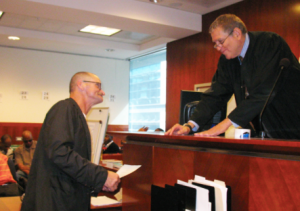
THE SUCCESS OF CAL.PROP. 47 REFORM WILL NOT IMPACT DRUG COURTS
California’s PROP. 47 did many things and did most of them right. According to Stanford Law School’s “One Year Progress Report”‘ released on Oct 29th, as to PROP 47 cases; recidvism is down, incarceration is down, felony charges are down, and court and
custody costs are down.This is what criminal justice reform looks like.
The whole world should be watching as Prop. 47 is implemented. It reduces drug possession offenses and relatively minor property crimes to misdemeanors. It allows those with felony records to petittion the court to reduce their offenses to misdemeanors (and dismiss the offense where appropriate), opening up new opportunities to those stigmatized with a felony conviction. It saves Caifornia taxpayers hundreds of millions of dollars, freeing jails and prisons for those incorrigible and dangerous offenders who need to be there. It decriminalizes drug possession without legalizing serious drug use.
There’s no reason to be fearful for drug courts because of the passage of Prop.47. They will adapt. They will take offenders charged with serious and even violent felonies in their background. They willl rely on science/evidnece-based screening to weed out participants who may be destructive to the program, themselves, or their communities.
I might add that virtually all serious offenders leave prison one day, and that it is far better to prepare them for their return to society in an effective drug court like program than dropping them off on a street corner (I spent over a year implememnting a drug court like program, callled the San Francisco Parole Reentry Court, designed for serious offenders leaving prison, who turned out to be 80% less likely to return to prison than those on regular parole).
As Santa Clara County Judge Steven Manley describes so well in his L.A. Times OPED of Oct.21st, though Drug Courts have seen their numbers drop since Prop.47’s passage, drug courts are successfully adapting to the new circumstances. He describes the need to work with the serious drug offender, whether charged with a misdemeanor or felony. The research establishes quite conclusively that those with a serious drug problem, high risk of recidivism, or serious criminal history do especially well in an intensive community based program like drug court (as opposed to those with a low risk of recidivism, who are often impacted negatively by intensive rehabilitation programs).
There are critics galore (many from the law enforcement community) who only guage success by what’s happenned in the recent past. They refuse to make arrests on drug possession cases because misdemeanor cases aren’t serious enough to engage them or they merely cite the offender, leaving them to continue their illegal activities in the community. Law Enforcement needs to do their job and make arrests for misdemeanor drug possession offenses. Every felony drug offense reduced to a misdemeanor by Prop.47 has a maximum term of one year. That is not insignificant time and more than enough motivation to keep drug court participants and others similarly charged, on the straight and narrow path.
As a retired judge, I have sat in over fifty California Courthouses over the past 15 years, and my experience is that the vast majority of felony drug posession cases are resolved with felony (and in some cases misdemeanor) probation and minimal jail time (rarely receiving as much as a year in custody, and rarer still a prison sentence, unless there are other more serious offenses involved). That is reality.
Calling the offense a misdemeanor or felony has little impact on the arrest, charging, court process or the individual sentence. It does nothing to effect the offenders drug dependency (Researchers estimate that substantially less than 50% of drug offenders are actually dependent on drugs).
We need to base our drug court admissions and treatment protocols, and more importantly our overall sentencing policy, on evidence-based screening, designed to screen out those who don’t need or are otherwise inappropriate for the intensive supervision and treatment of a drug court. Finally, we need to begin the critical task of providing evidence-based sentences for all offenders, scientifically structured to have a rehabiltative impact where possible.
Don’t worry about drug courts. They are nothing if not flexible and adaptive.They are the chameleon of the criminal justice reform world. They will do just fine.

